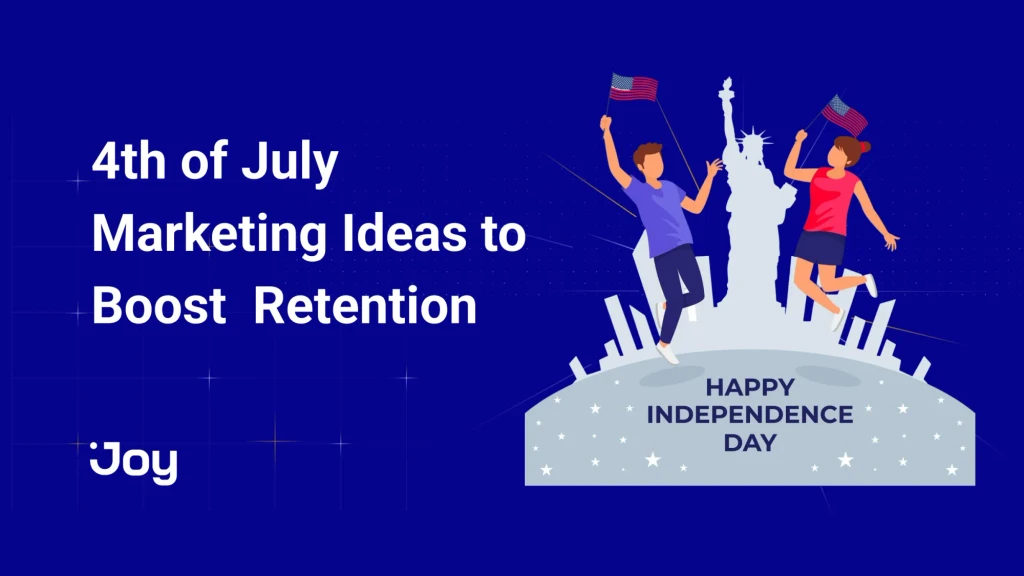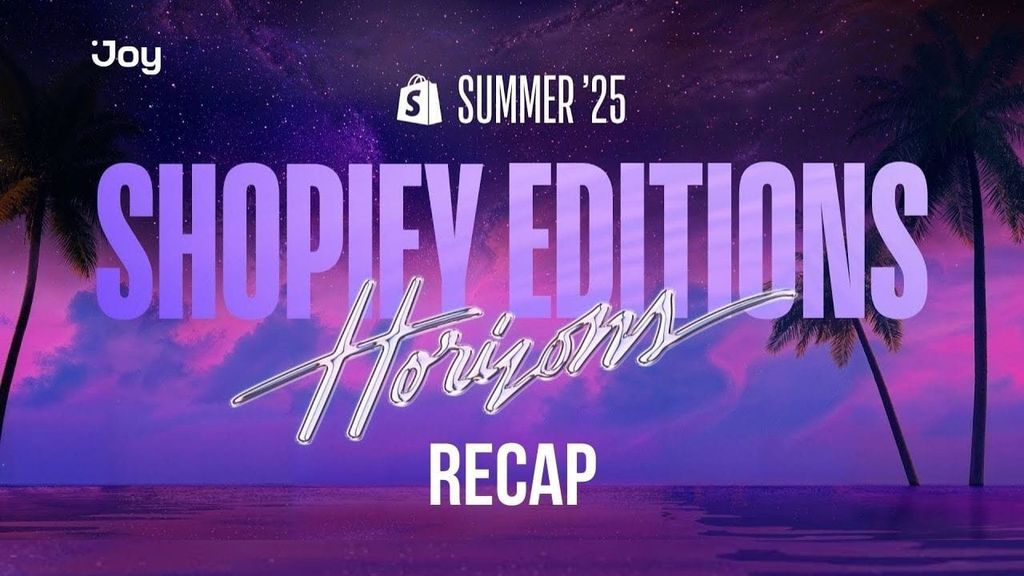The key to keeping customers is giving them great experiences. If they have a memorable time, they’re more likely to buy again, tell their friends, and engage with your brand. This applies to businesses selling to other businesses (B2B), too.
But surprisingly, only 10% of the B2B companies really focus on keeping their existing customers, as Gartner reported. This means there’s a huge opportunity for businesses to use modern customer retention tools, such as B2B loyalty programs, to thrive.
Let’s explore why B2B loyalty programs are no longer optional but essential for long-term success—and how you can leverage them to outperform the competition.
What Is A B2B Loyalty Program?
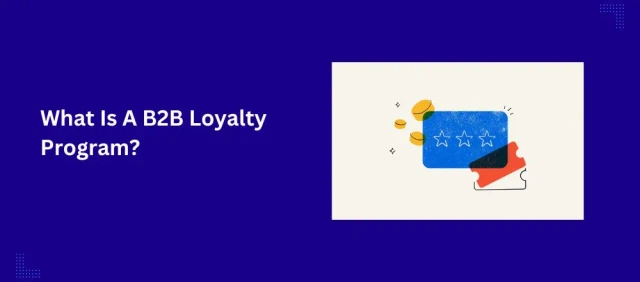
A B2B loyalty program is a strategic initiative designed to strengthen long-term partnerships between businesses, such as distributors, resellers, or corporate clients. Unlike B2C loyalty programs, which focus on short-term transactions and points-based perks, B2B programs aim to deliver long-term value through:
- Custom rewards like tiered pricing, rebates, or extended support
- Personalized contracts based on volume and partnership duration
- Exclusive benefits that enhance retention and increase switching costs
Key Differences: B2B vs B2C Loyalty Programs
| Factors | B2B Loyalty Programs | B2C Loyalty Programs |
| Target Audience | Businesses, distributors, wholesalers, and corporate clients. | Individual consumers. |
| Purchase Frequency | Less frequent but higher transaction values. | More frequent, smaller transactions. |
| Decision-Making Process | Involves multiple stakeholders (procurement teams, executives). | Usually, it is an individual decision. |
| Loyalty Incentives | Custom contracts, tiered pricing, rebates, exclusive services. | Points, discounts, free products, early access. |
| Customer Relationship | Long-term partnerships with high switching costs. | Shorter-term relationships, easier brand-switching. |
| Personalization | Highly customized based on business needs & contract terms. | More generalized, broad-market appeal. |
| Reward Structure | Based on bulk orders, contract duration, and referrals. | Based on purchase frequency, engagement, and social sharing. |
How B2B Loyalty Programs Benefit Your Business
A well-designed B2B loyalty program helps drive sustainable business growth by strengthening client relationships and increasing customer lifetime value. Key benefits include:
- Improved Customer Retention: Encourage long-term commitment and reduce churn through exclusive rewards, tiered incentives, and contract-based benefits.
- Higher Repeat Purchases: Motivate larger and more frequent orders with volume-based discounts and milestone rewards.
- Stronger B2B Relationships: Loyalty programs reinforce trust and build long-term business relationships, reducing the risk of switching to competitors.
- More Opportunities to Upsell & Cross-Sell: Use loyalty data to identify expansion potential and promote relevant upgrades or complementary services.
- Better Customer Engagement & Feedback: Personalized rewards drive deeper B2B customer engagement and generate valuable insights to improve offerings.
Examples of Successful B2B Loyalty Programs
Here are six real-world examples of successful B2B loyalty programs:
1. Lenovo 360 Expert Achievers Program (LEAP)
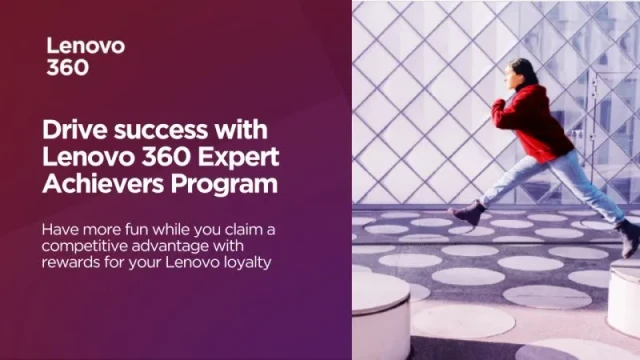
Lenovo is a global technology leader renowned for designing, manufacturing, and marketing a wide range of products, including personal computers, tablets, smartphones, workstations, servers, electronic storage devices, IT management software, and smart televisions.
To strengthen its partner ecosystem, Lenovo launched the LEAP (Lenovo Expert Achievers Program), a loyalty initiative designed to reward, educate, and empower channel partners. The program is structured around three key pillars:
- Sell and Earn – Partners earn points for selling eligible Lenovo products and services. A pre-loaded invoice system simplifies claims, allowing points to be distributed among team members.
- Learn and Earn – Training courses and certifications on Lenovo’s products also generate points, encouraging sales teams to enhance their expertise.
- Reward and Profit – Earned points can be redeemed for a variety of rewards, including prepaid Lenovo Mastercards and popular gift vouchers like Amazon e-gift cards.
Key Successes and Lessons Learned
- Stronger Partner Engagement – Rewarding individuals, not just companies, increases motivation and commitment.
- Knowledge-Driven Sales – By integrating learning with rewards, the program ensures partners are well-equipped to sell Lenovo solutions effectively.
- Flexible and Attractive Rewards – A variety of redemption options makes participation more appealing to different types of partners.
- Efficient Claim Process – Automating invoice claims reduces administrative workload, making it easier for partners to participate.
2. Salesforce Partner Program
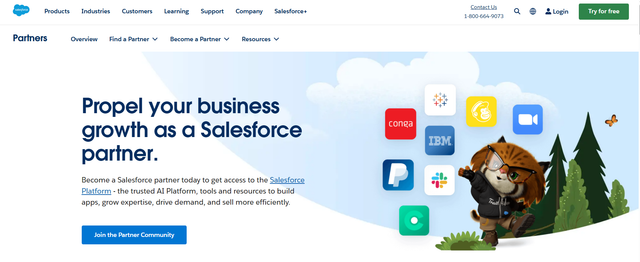
Salesforce is a global SaaS leader in CRM, customer success, and cloud-based business applications. Its Partner Program is designed not just as a rewards initiative, but as a full-fledged ecosystem loyalty strategy that fuels co-growth.
How the Brand Runs Its B2B Loyalty Program
Salesforce rewards partners through a combination of tiered recognition, joint go-to-market opportunities, and enablement tools:
- Tier-Based Access: Partners advance through tiers (Registered, Silver, Gold, Platinum) based on certifications, client success, and innovation impact.
- Co-Selling & Referrals: Top-tier partners gain access to Salesforce sales teams, priority leads, and pipeline-sharing programs.
- Marketing Development Funds (MDF): Salesforce co-invests in partners’ marketing campaigns, events, and content to drive joint demand generation.
Key Successes and Lessons Learned
- Loyalty as a Co-Growth Engine: Instead of points or cash, Salesforce offers long-term revenue growth through ecosystem integration.
- Elevated Trust and Alignment: Shared success metrics and lead access align partner goals with Salesforce’s GTM.
- Strategic Depth over Volume: The program rewards quality of engagement, not just quantity of sales.
3. IBM Partner Plus
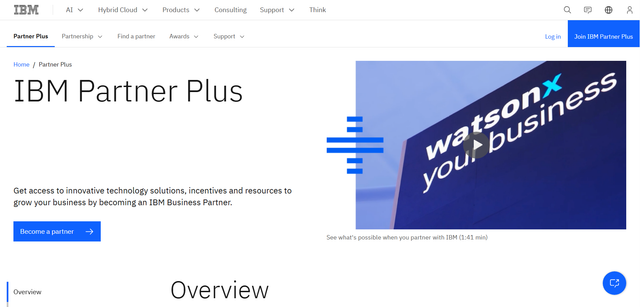
IBM, a pioneer in AI, hybrid cloud, and enterprise IT, restructured its Partner Plus Program to encourage innovation collaboration, not just transactional sales.
How the Brand Runs Its B2B Loyalty Program
IBM incentivizes partners to co-develop solutions, build on IBM technologies, and participate in ecosystem expansion:
- Build & Sell Model: Rewards are given when partners create custom solutions using IBM Cloud, Watson, or Data platforms.
- Access to Innovation Tools: Partners get early access to APIs, co-development environments, and AI training datasets.
- Strategic Tiering: Loyalty tiers are based on specialization, solution validation, and thought leadership—not just volume.
Key Successes and Lessons Learned
- Innovation = Loyalty: IBM shifts loyalty from revenue-driven to capability-driven partnership.
- Co-creation Strengthens Stickiness: Partners feel invested, not just incentivized.
- Tech-Based Differentiation: Loyalty here also means becoming part of IBM’s future product roadmap.
4. American Express® Partners Plus Program
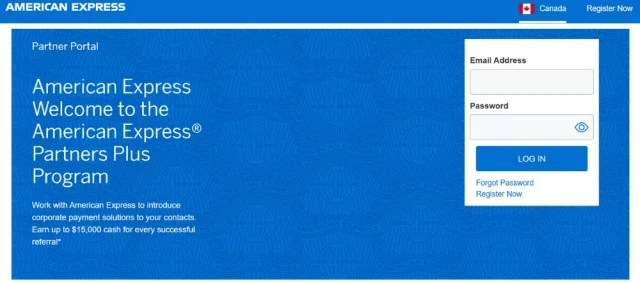
American Express (Amex) is a globally recognized financial services corporation, offering a range of products, including credit and charge cards, travel services, and financial solutions for both consumers and businesses. Renowned for its premium offerings and exceptional customer service, Amex has built a strong reputation worldwide.
How the Brand Runs Its B2B Loyalty Program
American Express launched the Partners Plus Program, a B2B referral-based loyalty initiative that incentivizes businesses and affiliates to promote Amex corporate cards and financial products.
- Referral-Driven Incentives: Businesses, affiliates, and professional service providers can refer clients to Amex’s corporate payment solutions. Each successful referral earns monetary rewards, statement credits, or marketing incentives.
- Seamless Update: Partners will receive referrals and commission earnings updates via emails from Amex, ensuring transparency.
Key Successes and Lessons Learned
- B2B Referrals Are a Powerful Growth Tool: Amex successfully leveraged word-of-mouth marketing among business networks to increase card adoption.
- Trust & Credibility Drive Conversions: Since Amex is a well-established financial brand, businesses were more willing to refer and recommend their solutions—a crucial factor in B2B loyalty success.
5. Celebrity Cruises Celebrity Rewards
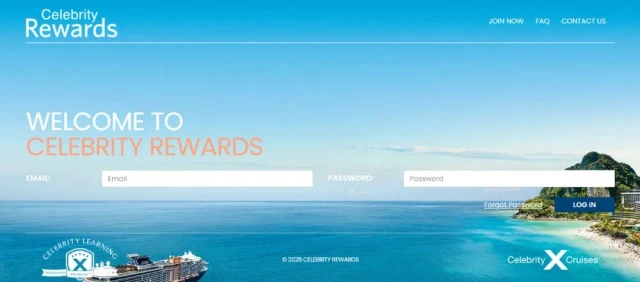
Celebrity Cruises is a premium cruise line renowned for its modern luxury offerings, innovative ship designs, and exceptional guest experiences. Operating globally, Celebrity Cruises caters to discerning travelers seeking upscale accommodations, diverse culinary options, and immersive itineraries.
How the Brand Runs Its B2B Loyalty Program
The Celebrity Rewards program is a tiered loyalty program designed to reward and incentivize travel agents who book cruises with Celebrity Cruises. Here’s how it works:
- Earning Points: Travel agents earn points for every Celebrity Cruises booking they make. These points accumulate over time, encouraging continuous engagement and sales efforts.
- Redeeming Rewards: Accumulated points can be redeemed for cash, which is loaded onto a reloadable Celebrity Rewards Mastercard. This direct monetary incentive provides immediate and tangible benefits to the agents, enhancing motivation.
- Exclusive Tiers: The program features an elite tier known as the Iconic Advisor Club, which is by invitation only. Members of this tier enjoy 12 months of access to exclusive benefits and elevated rewards, including special point promotions and unique invitations, fostering a sense of prestige and recognition among top-performing agents.
Key Successes and Lessons Learned
- Targeted Incentives: By focusing rewards on individual travel agents, Celebrity Cruises effectively motivates those directly responsible for sales, leading to increased bookings and market share.
- Flexible Rewards System: The ability to convert points directly into cash via a reloadable Mastercard offers flexibility and immediate gratification, making the program more appealing to participants.
- Recognition of Top Performers: Introducing an exclusive tier like the Iconic Advisor Club acknowledges and rewards top-performing agents, fostering loyalty and encouraging others to aspire to higher performance levels.
- Adaptability: The program’s structure allows Celebrity Cruises to adapt and tailor incentives based on market conditions and business objectives, demonstrating resilience and strategic agility.
6. Adobe Solution Partner Program
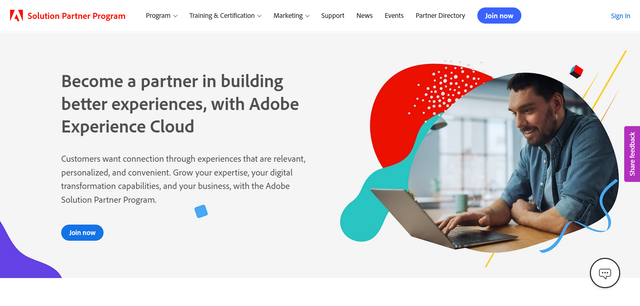
Adobe, known for its Creative Cloud and enterprise solutions, runs a Solution Partner Program focused on rewarding partners who manage full customer lifecycles, not just one-time sales.
How the Brand Runs Its B2B Loyalty Program
Adobe uses its program to align loyalty with retention, upsell, and customer value metrics:
- Lifecycle Incentives: Rewards are based on partner performance across onboarding, adoption, renewal, and upsell of Adobe tools.
- Performance-Based Tiers: Tiers reflect success in multi-year client relationships and product expansion.
- Co-Marketing and Sales Enablement: Adobe funds campaigns and provides advanced sales tools for top partners.
Key Successes and Lessons Learned
- Loyalty Through Lifecycle Mastery: Adobe ties rewards to long-term customer success, not short-term volume.
- Retention = Competitive Edge: By helping partners reduce churn, Adobe indirectly strengthens its own base.
- Aligned Metrics Build Trust: Shared KPIs foster transparency and stronger partner alignment.
4 Key Features Of A B2B Loyalty Program That Works
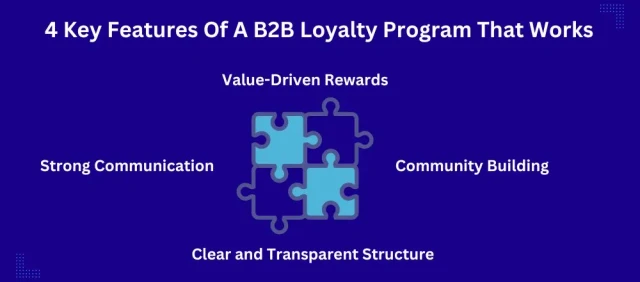
A strong B2B loyalty program includes more than just points. It should be designed around value-added experiences and sustainable incentives:
1. Value-Driven Rewards:
B2B clients don’t engage with loyalty programs for small discounts or generic perks—they want tangible, business-focused rewards that help them grow and optimize their operations.
Here’s what you can offer:
- Monetary incentives: Rebates, tiered discounts, and cash-back based on purchasing volume.
- Exclusive access & perks: Early access to new products, VIP support, or beta-testing opportunities.
- Growth-focused benefits: Co-marketing funds, free training, or business expansion tools.
2. Clear and Transparent Structure:
Unlike B2C customers, B2B buyers are more analytical and require a clear understanding of how the loyalty program works before they commit. A complicated or vague rewards structure can lead to low engagement and abandonment.
A good B2B loyalty program should have:
- Simple Tiering System: Clearly define how clients move up the loyalty ladder and what each tier offers.
- Straightforward Points System: Make it easy to earn, track, and redeem rewards.
- No Hidden Rules: Avoid unnecessary restrictions or expiration dates that discourage participation.
- Accessible Tracking & Reporting: Provide a digital dashboard where users can monitor their progress, earnings, and redemptions.
3. Community Building:
B2B loyalty programs aren’t just about transactions—they should also foster relationships within a brand’s business network. Community-driven programs create stronger brand loyalty and encourage long-term collaboration.
Best Practices:
- Member-Only Forums & Networking Events: Encourage collaboration and knowledge-sharing among top-tier partners.
- Exclusive Training & Certification Programs: Offer education and upskilling opportunities to help clients maximize the value of your products.
- Co-Marketing & Business Support: Provide co-branding opportunities, marketing resources, or sales enablement tools to high-value partners.
- Recognition & Spotlights: Feature top customers and partners in case studies, testimonials, or industry events.
4. Strong Communication:
Many B2B loyalty programs fail due to a lack of engagement, which is often a result of poor communication. If members don’t fully understand the program, they won’t maximize its benefits. Consistent, clear communication is key to keeping businesses actively engaged.
Best Practices:
- Automated & Personalized Updates: Send customized email updates on points balance, tier progress, and new reward opportunities.
- Regular Program Optimization & Feedback Loops: Gather insights from participants and continuously refine the program.
- Dedicated Account Support: Offer priority assistance or dedicated managers for high-tier members.
- Multi-Channel Engagement: Use a mix of email, webinars, SMS, and in-app notifications to keep businesses informed.
Common Challenges in Building A B2B Loyalty Program
Building a successful B2B loyalty program isn’t just about offering rewards—it requires strategic planning, seamless execution, and continuous optimization. Here are some of the most common challenges businesses face when implementing a B2B loyalty program:
Low Engagement Rates
B2B loyalty programs often struggle with maintaining active participation due to lengthy sales cycles, infrequent transactions, or misalignment between rewards and business needs. This can lead to:
- Infrequent use: Businesses may not actively engage, causing participation to drop significantly over time.
- Reduced perceived value: Members may question the usefulness or relevance of the loyalty incentives offered.
- High churn rates: Without regular engagement, companies quickly lose interest and eventually exit the program.
Program Complexity
B2B loyalty programs typically involve complex structures with multiple tiers, eligibility criteria, and stakeholders. This complexity can result in:
- User confusion: Businesses find it difficult to understand how the program works or how they can benefit.
- Administrative challenges: Companies managing the program face difficulties tracking, implementing, and communicating rules effectively.
- Slow adoption: Complexity can hinder rapid adoption, limiting the effectiveness and growth of the loyalty program.
Data & Privacy Concerns
B2B programs must handle sensitive customer and business data, making privacy and data security critical concerns. This can lead to:
- Data sharing hesitance: Businesses may be reluctant to share necessary data due to competitive sensitivity and security concerns.
- Increased compliance risks: Handling sensitive data requires adherence to strict privacy regulations, increasing operational complexity and potential liability.
- Limited personalization: Difficulty collecting data can restrict the program’s ability to personalize experiences, thus limiting effectiveness.
Measuring ROI Effectively
Due to longer sales cycles and indirect buying behaviors in B2B markets, accurately measuring the return on investment of loyalty programs can be challenging. This often results in:
- Unclear business impact: Organizations may struggle to link loyalty activities directly to sales growth or profitability.
- Delayed decision-making: Lack of clear ROI metrics may slow down internal decision-making processes, affecting future program funding and adjustments.
- Difficulty securing internal buy-in: Without clear ROI data, convincing stakeholders to continue investing in loyalty programs becomes difficult.
Changing Customer Expectations
B2B buyers increasingly expect consumer-like experiences—personalized, digital-first, and highly responsive. Failure to meet these expectations can lead to:
- Customer dissatisfaction: Businesses feel the program fails to meet their evolving expectations of personalization and convenience.
- Competitive disadvantage: Companies not adapting quickly enough risk losing loyalty to competitors offering better experiences.
- Need for constant innovation: Organizations must continually evolve loyalty strategies and adopt new technologies to keep pace with changing demands.
Future Trends in B2B Loyalty Programs: What’s Next?
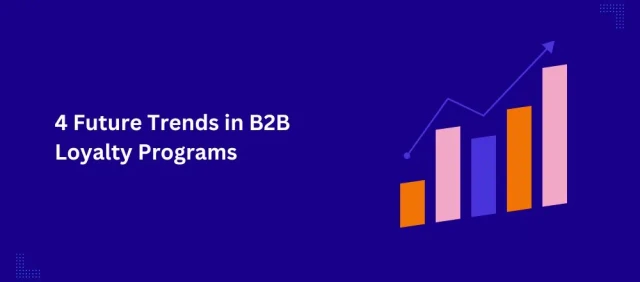
The future of B2B loyalty will be more data-driven, personalized, and value-focused than ever before. Here are four major trends shaping the future of B2B loyalty programs:
The Rise of Blockchain & Decentralized Loyalty Programs
Blockchain technology enables secure, transparent, and decentralized loyalty programs that enhance trust between businesses and their B2B customers. It simplifies reward tracking, reduces fraud, and facilitates seamless, real-time reward redemption. Businesses can build interconnected loyalty ecosystems without intermediaries.
Example: Singapore Airlines launched the KrisPay digital wallet, utilizing blockchain technology to securely track and redeem loyalty points instantly across its partner network.
AI-driven Hyper-Personalization in B2B Rewards
AI is making hyper-personalization possible by analyzing customer behavior, purchasing patterns, and engagement levels.
How AI is Enhancing B2B Loyalty Programs:
- Predictive Analytics for Custom Rewards: AI analyzes historical purchasing behavior to recommend personalized rewards.
- Automated Loyalty Tier Adjustments: Businesses are automatically upgraded based on engagement patterns.
- Personalized Communication & Offers: AI curates unique loyalty emails, notifications, and promotional offers for each client.
Example: Salesforce’s Einstein AI suggests customized incentives for clients based on past interactions and predicted needs.
Subscription-based Loyalty Models in B2B
More B2B businesses are shifting from one-time transactions to recurring revenue models, and loyalty programs are evolving to reflect this trend. Subscription-based loyalty programs are gaining traction in industries like SaaS, IT services, and wholesale distribution.
Example: Adobe Creative Cloud’s subscription model ensures long-term loyalty through continuous feature updates and exclusive subscriber benefits.
The Shift from Transactional Incentives to Value-based Loyalty Strategies
B2B loyalty is evolving beyond simple transactional rewards towards deeper value-driven strategies that build stronger emotional and strategic relationships. Companies now focus on providing holistic business value, emphasizing knowledge sharing, partnership, and long-term growth rather than just immediate incentives. This shift fosters enduring loyalty and mutual business success.
Example: HubSpot’s Solutions Partner Program rewards partners not just through financial incentives but also by providing training, certification, collaborative marketing resources, and long-term strategic support, promoting mutual business success.
Bottom Line
As B2B loyalty programs evolve, businesses must embrace new technologies, focus on personalization, and create deeper value-based relationships with their customers. The future of loyalty isn’t just about transactions—it’s about trust, intelligence, and long-term collaboration.


